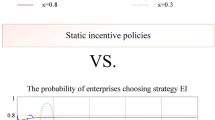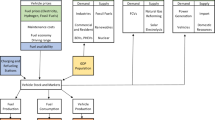Abstract
In this paper, environmental policymaking based on sustainable development was evaluated in Tehran to increase the penetration of plug-in hybrid electric vehicles. First, different aspects of sustainable development, including the environmental, economic, social, and technical aspects of Tehran’s vehicles from 2002 to 2018, were examined through the extended sustainable development model. The model documented the unsustainability of the development of vehicles in Tehran, the main reason for which could be the current air pollution in this city. Following this, based on the principle of sustainable development, some policy indices for the development of plug-in hybrid electric vehicle penetration were introduced and ranked using the fuzzy TOPSIS method, which ranked in the point of view of two players, namely buyers of vehicles and the state. Finally, to find the appropriate policy index, using the game theory method and taking the vehicle buyer and the state as the players, the Nash equilibrium point was defined as an appropriate policy for the development of plug-in hybrid electric vehicles. Thus, using the data obtained, the number of these vehicles for the year 2032 was estimated.
Graphic abstract












Similar content being viewed by others
Abbreviations
- PHEV:
-
Plug-in hybrid electric vehicles
- EV:
-
Electric vehicle
- CV:
-
Conventional vehicle
- BEV:
-
Battery electric vehicles
- HEV:
-
Hybrid electric vehicles
- SD:
-
Sustainable development
- NHS:
-
Nature, human, and system
- ANP:
-
Analytical network process
- WHO:
-
World Health Organization
- V2G:
-
Vehicle-to-grid
- G2V:
-
Grid-to-vehicle
- TLS:
-
Time–location shifting
References
Ahn J, Woo J, Lee J (2015) Optimal allocation of energy sources for sustainable development in South Korea: focus on the electric power generation industry. Energy Policy 78:78–90
Attia M, Sedjelmaci H, Senouci S, Aglzim EH (2016) Game model to optimally combine electric vehicles with green and non-green sources into an end-to-end smart grid architecture. J Netw Comput Appl 72:1–13
Axsen J, Kurani K (2009) Anticipating PHEV energy impacts in california. Institute of transportation studies. Transp Res Part D 15:212–219
Boren S, Ny H (2016) A strategic sustainability analysis of electric vehicles in EU today and towards 2050. Int J Environ Chem Ecol Geol Geophys Eng 10(3):294–302
Chen SJ, Hwang CL (1992) Fuzzy multiple attribute decision making: methods and applications. Springer, Berlin
Davidov S, Panto M (2017) Planning of electric vehicle infrastructure based on charging reliability and quality of service. Energy 118:1156–1167
El-Santawy MF (2012) A VIKOR method for solving personnel training selection problem. Int J Comput Sci 1(2):9–12
Green RC, Wang L, Alam M (2010) The impact of plug-in hybrid electric vehicles on distribution networks: a review and outlook. In: Power and energy society general meeting, pp 544–553
Guo S, Zhao H (2015) Optimal site selection of electric vehicle charging station by using fuzzy TOPSIS based on sustainability perspective. Appl Energy 158:390–402
Haghshenas H, Vaziri M, Gholamialam A (2015) Evaluation of sustainable policy in urban transportation using system dynamics and world cities data: a case study in Isfahan. Cities 45:104–115
Jafari H, Hejazi SR, Rasti-Barzoki M (2017) Sustainable development by waste recycling under a three-echelon supply chain: a game-theoretic approach. J Clean Prod 142:2252–2261
Javid RJ, Nejat A (2017) A comprehensive model of regional electric vehicle adoption and penetration. Transp Policy 54:30–42
Kougias I, Karakatsanis D, Malatras A, Monforti-Ferrario F, Theodossiou N (2016) Renewable energy production management with a new harmony search optimization toolkit. Clean Technol Environ Policy 18:2603–2612
Langbroek JHM, Franklin JP, Susilo YO (2016) The effect of policy incentives on electric vehicle adoption. Energy Policy 94:94–103
Lechman KJ, Selech J, Kasprzak J (2019) Eco-efficiency analysis of an innovative packaging production: case study. Clean Technol Environ Policy 21:339–350
Lee Y, Kim C, Shin J (2016) A hybrid electric vehicle market penetration model to identify the best policy mix: a consumer ownership cycle approach. Appl Energy 184:438–449
Li Y, Davis C, Lukszo Z, Weijnen M (2016) Electric vehicle charging in China’s power system: energy, economic and environmental trade-offs and policy implications. Appl Energy 173:535–554
Madani K, Hooshyar M (2014) A game theory–reinforcement learning (GT–RL) method to develop optimal operation policies for multi-operator reservoir systems. J Hydrol 519:732–742
Meyar-Naimi H, Vaez-Zadeh S (2012) Developing a DSR-HNS policy making framework for electric energy systems. Energy Policy 42:616–627
Moradi S, Limaei SM (2018) Multi-objective game theory model and fuzzy programming approach for sustainable watershed management. Land Use Policy 71:363–371
Neck R (2010) Dynamic game theory and models of international macroeconomic policy. In: recent advances in applied mathematics, conference paper, January 2010, pp 37–42
Poullikkas A (2015) Sustainable options for electric vehicle technologies. Renew Sustain Energy Rev 41:1277–1287
Prebeg P, Gasparovic G, Krajacic G, Duic N (2016) Long-term energy planning of Croatian power system using multi-objective optimization with a focus on renewable energy and integration of electric vehicles. Appl Energy 184:1493–1507
Proskuryakova L (2018) Updating energy security and environmental policy: energy security theories revisited. J Environ Manag 223:203–214
Pye S, Sabio N, Strachan N (2015) An integrated systematic analysis of uncertainties in UK energy transition pathways. Energy Policy 87:673–684
Sadeghi-Barzani P, Rajabi-Ghahnavieh A, Kazemi-Karegar H (2014) Optimal fast charging station placing and sizing. Appl Energy 125:289–299
Samaie F, Meyar-Naimi H, Javadi S, Feshki-Farahani H (2020) Comparison of sustainability models in development of electric vehicles in Tehran using fuzzy TOPSIS method. Sustain Cities Soc 53:101912
Sellitto MA, Borchardt M, Pereira GM, Bubicz ME (2014) Tool for environmental performance assessment of city bus transit operations: case studies. Clean Technol Environ Policy 17(4):1053–1064
Shareef H, Mainulislam M, Mohamed A (2016) A review of the stage-of-the-art charging technologies, placement methodologies, and impacts of electric vehicles. Renew Sustain Energy Rev 64:403–420
Silvia C, Krause RM (2016) Assessing the impact of policy interventions on the adoption of plug-in electric vehicles: an agent-based model. Energy Policy 96:105–118
Statharas S, Moysoglou Y, Siskos P, Zazias G, Capros P (2019) Factors influencing electric vehicle penetration in the EU by 2030: a model-based policy assessment. Energies 12(14):2739
Wang N, Tang L, Pan H (2018) A global comparison and assessment of incentive policy on electric vehicle promotion. Sustain Cities Soc 44:597–603
Wesseling JH (2016) Explaining variance in national electric vehicle policies. Environ Innov Soc Transit 21:28–38
Yang I (2018) A dynamic game approach to distributionally robust safety specifications for stochastic systems. Automatica 94:94–101
Zhang X, Xie J, Rao R, Liang Y (2014) Policy incentives for the adoption of electric vehicles across countries. Sustainability 6(11):8056–8078. https://doi.org/10.3390/su6118056
Zhou Y, Wang M, Hao H, Johnson L, Wang H (2015) Plug-in electric vehicle market penetration and incentives: a global review. Mitig Adapt Strateg Glob Change 20(5):777–795. https://doi.org/10.1007/s11027-014-9611-2
Zhu L, Zhang Q, Lu H, Li H, Li Y, McLellan B, Pan X (2017) Study on crowdfunding’s promoting effect on the expansion of electric vehicle charging piles based on game theory analysis. Appl Energy 196:238–248
Acknowledgements
The authors thank for all supports of Islamic Azad University, Central Tehran Branch, and also for the cooperation of P.Porto University from Portugal especially Professor Jose C. Quadrado and Professor Ana M. Madureira who cooperated with the second author during his sabbatical leave there.
Author information
Authors and Affiliations
Corresponding author
Ethics declarations
Conflict of interest
The authors declare that they have no conflict of interest.
Additional information
Publisher's Note
Springer Nature remains neutral with regard to jurisdictional claims in published maps and institutional affiliations.
Electronic supplementary material
Below is the link to the electronic supplementary material.
Rights and permissions
About this article
Cite this article
Samaie, F., Javadi, S., Meyar-Naimi, H. et al. Environmental sustainability policy on plug-in hybrid electric vehicle penetration utilizing fuzzy TOPSIS and game theory. Clean Techn Environ Policy 22, 787–801 (2020). https://doi.org/10.1007/s10098-020-01821-2
Received:
Accepted:
Published:
Issue Date:
DOI: https://doi.org/10.1007/s10098-020-01821-2




